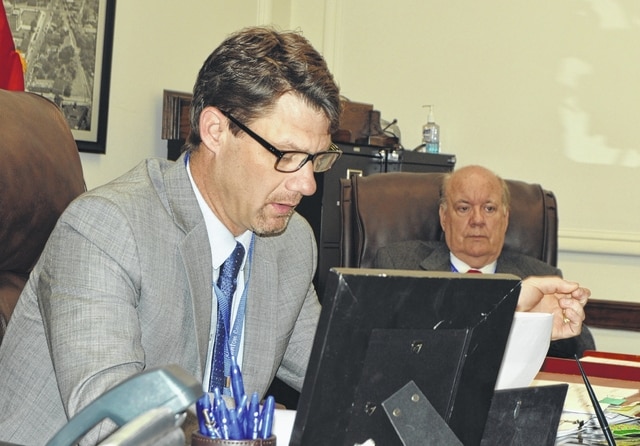
WILMINGTON — Commissioners opted Wednesday for property insurance coverage that — in the event the courthouse were destroyed in a catastrophe — there’d be enough funds for a replacement office building, but not enough to reproduce the historical structure’s adorned interior.
A new 60,000-square-foot replacement facility with courtrooms and offices would cost $26 million, according to an appraiser. But the appraiser thinks it would take $45 million to re-create with craftsmanship the courthouse and all its artwork and stonework as visitors see it today, said Clinton County Commissioner President Kerry R. Steed.
Clinton County Commissioner Patrick Haley wondered whether, even though the added dollars would be provided by the insurer, there would be the needed craftspeople to bring in and duplicate the work done nearly a century ago.
Haley reiterated what he said during a prior discussion on the topic: He thinks there would be “a great debate” in the community what to do if the historical courthouse, an identifying landmark in the county, were lost to a fire or tornado. Some would question or oppose reproducing the building because of the greater cost in taxpayer money, Haley mentioned previously.
The vote Wednesday was 3-0 to choose the insurance plan that would replace, but not try to reproduce, the courthouse were it a total loss.
The annual premium for the coverage plan chosen is $9,582 less than the premium would be for the more expensive coverage that would provide funds to re-create the building in its current form.
In other business, county commissioners held off on a vote whether to approve certain bills after Commissioner Brenda K. Woods said she wanted clarification on where 21 monitors for the county auditor’s office are going. Haley agreed there is a need for clarification, and Clinton County Administrator Mary Ann Foland said she will follow up.
The total cost of the 27-inch computer monitors is $3,794.
Last week, the board of commissioners received a written request from Clinton County Auditor Terence “Terry” G. Habermehl asking for additional office space for his staff.
“My office is overcrowded and not conducive to a productive work environment,” Habermehl wrote.
“There is also no privacy. Out of necessity, payroll and internal issues are discussed in the presence of the public and other employees,” the auditor added.
Habermehl thinks the proximity of office staffers to one another raises health concerns, and increases the instances of sick days.
“On a recent workday, almost half of my staff was out due to illness while others worked while sick,” he stated.
A need to coordinate and optimize office space needs among various county departments was raised last year, in particular the needs for greater space for the Board of Elections and the Adult Probation Department. Both of those functions are located in the courthouse.
Steed said Wednesday the commissioners acknowledge a need to assess the current uses of space at the courthouse and at other county-owned facilities. At this juncture, the question is whether to hire an outside agency to make the space assessments, or have the county itself “go around and interview and assess” the question of space and solutions, he said.
Reach Gary Huffenberger at 937-556-5768.


